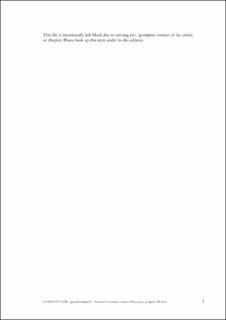| dc.contributor.author | Kverndokk, Snorre | |
| dc.contributor.author | Figenbaum, Erik | |
| dc.contributor.author | Hovi, Jon | |
| dc.coverage.spatial | Norway | en_US |
| dc.date.accessioned | 2021-07-28T10:10:26Z | |
| dc.date.available | 2021-07-28T10:10:26Z | |
| dc.date.created | 2020-01-26T18:33:14Z | |
| dc.date.issued | 2020-01-28 | |
| dc.identifier.citation | Resource and Energy Economics. 2020, 60 (May), 1-25. | en_US |
| dc.identifier.issn | 0928-7655 | |
| dc.identifier.uri | https://hdl.handle.net/11250/2765509 | |
| dc.description.abstract | Aiming to reduce the number of brown (polluting) cars on the road, several countries currently promote the purchase and use of green (emission-free) cars through financial and non-financial incentives. We study how such incentives affect consumers who continue to drive brown cars. Using a simple model, we analyze the effects of policy instruments such as subsidizing green cars, taxing brown cars, and allowing green cars to drive in bus lanes. Car owners are influenced by price incentives as well as by external effects from traffic (such as congestion) both in regular lanes and in bus lanes. An extension of the model also considers how changes in local driving habits affect brown-car driving. We find that subsidizing green cars and allowing them to drive in bus lanes might increase brown-car driving. We also report the results of a recent survey containing questions specifically designed to tap the significance of the model’s core mechanisms. The results are partially consistent with propositions derived from the model. While most brown-car respondents report their driving was unchanged after the implementation of the policies to promote green cars, some – particularly in major cities – report that these policies caused them to reduce or increase their driving. We conclude that some mechanisms in our model are more important than others and that certain mechanisms appear to influence different brown-car drivers in different ways. Overall, it seems that Norwegian policies to promote the transition from brown to green cars have somewhat reduced brown-car driving. | en_US |
| dc.language.iso | eng | en_US |
| dc.publisher | Elsevier | en_US |
| dc.rights | Attribution-NonCommercial-NoDerivatives 4.0 Internasjonal | * |
| dc.rights.uri | http://creativecommons.org/licenses/by-nc-nd/4.0/deed.no | * |
| dc.title | Would my driving pattern change if my neighbor were to buy an emissions-free car? | en_US |
| dc.type | Peer reviewed | en_US |
| dc.type | Journal article | en_US |
| dc.rights.holder | © 2020 Elsevier B.V. All rights reserved. | en_US |
| dc.source.articlenumber | 101153 | en_US |
| dc.description.version | acceptedVersion | en_US |
| cristin.ispublished | true | |
| cristin.fulltext | original | |
| cristin.qualitycode | 1 | |
| dc.identifier.doi | 10.1016/j.reseneeco.2020.101153 | |
| dc.identifier.cristin | 1782241 | |
| dc.source.journal | Resource and Energy Economics | en_US |
| dc.source.volume | 60 | en_US |
| dc.source.issue | May | en_US |
| dc.source.pagenumber | 1-25 | en_US |
| dc.relation.project | Norges forskningsråd: 209698 | en_US |

